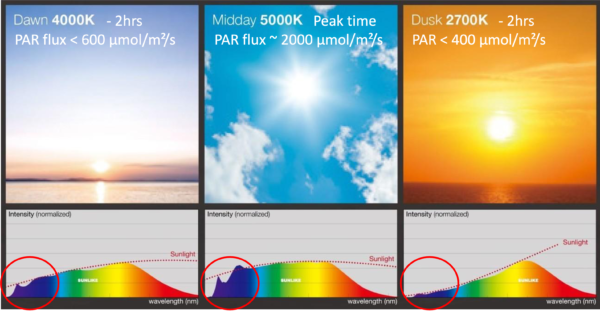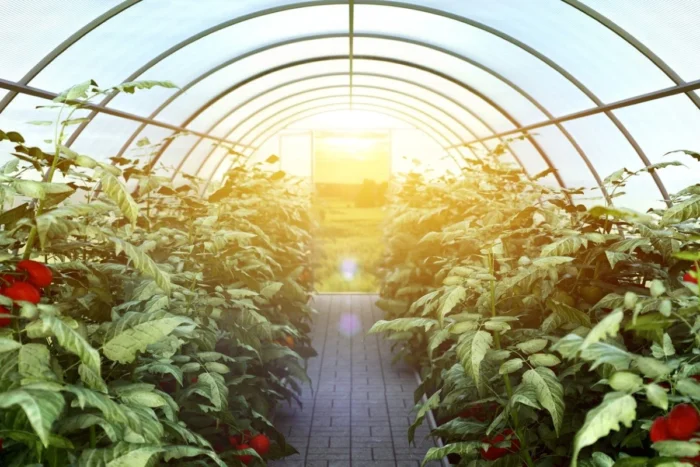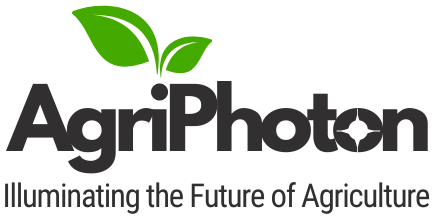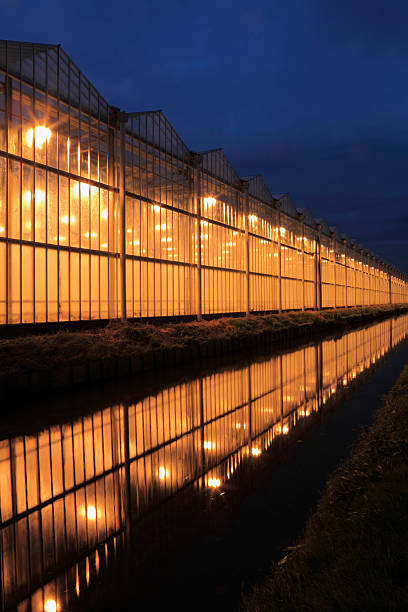AgriPhoton helps greenhouse growers boost yields, accelerate cycles, and improve crop consistency—using the sunlight they already have.
How It Works
AgriPhoton enhances natural sunlight as it enters the greenhouse—
giving crops more of the light they need and distributing it more evenly. The result is stronger, more profitable harvests.
Ideal For
Tomatoes, peppers, cucumbers, leafy greens—
any grower aiming for higher crop performance with minimal risk.

01.
AgriPhoton Technology
AgriPhoton’s advanced greenhouse films are engineered with semiconductor photonic innovation, setting a new benchmark in light management for controlled-environment agriculture. Designed for longevity and performance, they are a trusted choice for modern growers seeking both productivity and sustainability.
The durability and efficacy of greenhouse films are influenced by intrinsic material quality, optical precision, and resilience under diverse agronomic conditions. AgriPhoton’s films are crafted to perform consistently across varying climates, greenhouse types, and cultivation practices.
Developed to meet the evolving needs of high-efficiency agriculture, these films utilize semiconductor photonic elements to finely tune the light spectrum, enhancing the transmission of photosynthetically favorable wavelengths. This spectral optimization supports robust plant growth, improves crop quality, and extends seasonal productivity without increasing energy consumption. With integrated features such as UV resistance, superior light diffusion, and high thermal stability, AgriPhoton films reduce the need for artificial lighting while promoting more uniform canopy development.
Lightweight, easy to install, and low-maintenance, AgriPhoton films provide growers with a durable, high-performance solution that enables greater yield, energy efficiency, and sustainable cultivation.
02.
LIFETIME
AgriPhoton’s semiconductor photonic greenhouse solutions are engineered to deliver long-lasting performance, offering customizable spectral optimization through proprietary technology while maintaining mechanical resilience across multiple growing seasons.
The longevity of AgriPhoton products reflects their advanced design and superior material composition. The semiconductor photonic spray coating, developed through proprietary processes, enables targeted spectral enhancement for 4–6 growing seasons when applied to compatible films. The supportive base films, specifically formulated to complement the spray, provide 5–6 seasons of structural durability. For long-term installations, the standalone AgriPhoton film, composed of high-grade resins and next-generation semiconductor-based inorganic materials, delivers an extended lifespan of 6–10 seasons, setting a new industry standard in greenhouse film endurance.
This exceptional durability is made possible by AgriPhoton’s strategic integration of spectral engineering with material stabilization technologies. The films are fortified with precision-engineered combinations of UV stabilizers, antioxidants, and co-stabilizers that defend against UV degradation, thermal aging, and chemical stress. These additives are homogeneously incorporated into the polymer matrix, ensuring uniform protection and consistent performance across diverse climatic zones and cultivation practices.
AgriPhoton’s advanced stabilization system includes:
Selected semiconductor photonic materials with field-proven operational stability exceeding 5 years, offering high resistance to prolonged UV exposure and extreme environmental conditions.
PMMA (polymethyl methacrylate) and EVA (ethylene-vinyl acetate) as primary host resins, chosen for their proven durability in outdoor settings and their intrinsic resistance to photodegradation and agrochemical attack—ideal for high-yield, intensive cultivation systems.
The specific stabilization formulation is tailored to the grower’s needs, considering geographic location, greenhouse architecture, and agrochemical regimes, ensuring optimal performance under site-specific conditions.
With a commitment to durability, spectral precision, and environmental adaptability, AgriPhoton delivers a next-generation greenhouse film platform that enhances crop productivity, reduces operational costs, and supports sustainable agricultural practices.


03.
SUPERIOR STRENGTH
Agriphoton’s cutting-edge semiconductor films demonstrate the company’s unwavering commitment to excellence in material selection, process optimization, and stringent quality control protocols. By leveraging advanced semiconductor photonic technologies, Agriphoton has developed a line of films that offer exceptional mechanical strength, ensuring durability and reliability in agricultural environments.
The company’s latest innovation introduces a next-generation class of ultra-durable films, created from specially engineered photonic-infused materials. These films not only improve the structural integrity and longevity of greenhouse environments but also provide significant economic benefits. Remarkably, they can be produced with reduced thickness while maintaining or exceeding the mechanical strength of conventional materials. This breakthrough represents a major advancement in greenhouse technology, reinforcing Agriphoton’s commitment to delivering superior, high-performance solutions that push the boundaries of agricultural innovation.
04.
OPTIMAL LIGHT TRANSMISSION & DIFFUSION
AgriPhoton's photonic-infused films are designed to revolutionize light management within agricultural environments by enhancing light transmission and diffusion. Leveraging semiconductor nanomaterials with spherical properties, these films scatter light in all directions, significantly improving light distribution throughout the greenhouse. This ensures that even the lower canopy, which is often deprived of natural sunlight, receives adequate illumination. As a result, crops experience uniform growth rates across the entire plant structure.
AgriPhoton’s films ensure uniform light distribution, preventing the formation of hot spots and shadows that can disrupt photosynthesis. By maximizing light penetration, the films optimize the growing conditions for crops, leading to increased yields and healthier plants.
As sunlight enters a greenhouse, it undergoes a transformative process when passing through AgriPhoton’s semiconductor films, which separate direct and diffused light. Although the diffused light may give the film a slightly hazy appearance to the human eye, this haziness does not compromise the film’s overall transparency. Crucially, the Photosynthetic Active Radiation (PAR)—the light required by plants for photosynthesis—remains consistent and optimal.
The benefits of diffused light are well-established, particularly in spring and summer, as well as in regions with intense sunlight. These advantages include:
Even light distribution: Reduced shadows ensure that all plant sections receive adequate light, especially those in the lower canopy.
Protection against light stress: Diffused light helps prevent sunburn and introduces a mild cooling effect, optimizing the growing environment.
AgriPhoton’s films are available with different levels of light diffusion, each tailored to specific regional and plant needs:
Crystal-clear films with minimal diffusion, maximizing direct light for high-light environments.
Films with moderate diffusion, ideal for balanced light distribution.
Films with high diffusion, designed for areas with intense sunlight or where shading is required to prevent light stress.
The appropriate level of diffusion depends on several factors, including the local climate, plant type, and growing seasons. AgriPhoton’s team of experts is available to provide personalized consultations, ensuring the selection of the optimal diffusion level for each customer's unique growing conditions.


05.
PROLONGING DAYLIGHT TIME
Agriphoton’s film can effectively extend daylight hours within agricultural environments, improving light efficiency for crops. By harnessing advanced optical properties, these films enhance natural light absorption and distribution throughout the day.
Expands 2 Hours at Dawn: The films work by optimizing light diffusion at sunrise, capturing early morning sunlight that would otherwise be inefficiently distributed. This results in an additional two hours of light exposure in the morning, benefiting plant growth and photosynthesis early in the day.
Similarly, Expands 2 Hours at Dusk: In the evening, these films help prolong light availability by minimizing light scattering and enhancing the spread of available sunlight during dusk. This provides an additional two hours of effective daylight, ensuring crops continue to benefit from light as the sun sets.
This extended daylight period maximizes the amount of usable sunlight for photosynthesis, improving crop yields, energy efficiency, and overall productivity in greenhouses.
06.
THERMIC EFFECT
AgriPhoton’s greenhouse films, made with EVA or PMMA and embedded with semiconductor nanomaterials, act as effective thermal insulators—superior to glass or polycarbonate. In colder climates like Canada, these materials absorb solar radiation and convert part of it into infrared (IR), helping warm the greenhouse during the day while still transmitting essential PAR light for photosynthesis.
At night, the films’ multi-layer structure with IR-absorbing additives minimizes heat loss, maintaining a stable internal climate.
Key Benefits:
Frost Protection & Stable Night Temps: Shields crops from cold stress and slows temperature drops.
Energy Efficiency: Reduces heating needs, lowering operational costs.
Higher Yields & Earlier Maturity: Promotes faster, healthier plant growth.
Improved Crop Quality: Ensures uniform development and resilience.
AgriPhoton’s thermic films create a controlled, energy-efficient environment ideal for year-round, high-quality crop production.


07.
INHERENT DISEASE CONTROL
AgriPhoton has developed advanced photonic films designed to support disease and pest management in controlled-environment agriculture. These films align with the principles of Integrated Pest Management (IPM), offering a sustainable solution that reduces dependence on chemical pesticides.
A key innovation in this category is our UV-blocking photonic film, which filters out ultraviolet light up to 390 nm. This spectral modification delivers multiple benefits:
Insect Population Reduction: By limiting UV exposure, the film disrupts the visual cues used by pests such as whiteflies, thrips, aphids, and leaf miners, effectively lowering their presence and reducing the risk of virus transmission.
Disease Suppression: The UV-blocking properties help inhibit the sporulation and spread of fungal pathogens like Botrytis cinerea, contributing to healthier crop environments.
Enhanced Crop Aesthetics and Value: In ornamental crops such as red roses, the film prevents petal discoloration ("blackening"), improving their visual quality and market value.

